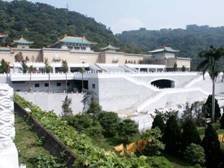 Taipei National Palace Museum Taipei National Palace Museum
The Taipei National Palace Museum and the famous Forbidden City in Beijing are derived from the same institution, which was split into two as a result of the Chinese Civil War. Covering a total area of 1200 mu (about 198 acres), the National Palace Museum is located in the outskirts of Taipei City, Taiwan. Construction started in 1962 and the museum was inaugurated on November 12, 1965, the 100th anniversary of the birth of Sun Yat-sen (1866-1925), the great Chinese revolutionary and founder of the Republic of China. Thus, the museum is also named as Yat-sen Museum. The Taipei National Palace Museum houses the largest collection of priceless Chinese artifacts and artwork in the world, including ancient bronze castings, calligraphy, scroll paintings, porcelain, jade, and rare books, many of which were possessions of the former imperial family. The full collection, which consists of some 650,000 pieces, spans many dynasties. Each exhibit, however, puts on display only about 1,700 pieces at a time. At this rate, assuming a duration of three months for each exhibit, it will take 100 years to cycle through the entire collection! Incredible!
Note:
1. No photographing in the Taipei National Palace Museum from June 1, 2005.
2. Please call or write in advance to make arrangements if you intend to visit the Chang Dai-ch'ien Memorial Residence.
TEL: (02)2881-2021-683
|
Admission Fee: |
Museum |
TWD100 (about RMB 25)for general audiences
TWD80 (about RMB 20)for groups of 20 or more |
|
Chih-shan Garden |
TWD 10 (about RMB 2.5) |
|
Chih-te Garden |
Free |
|
Opening Hour: |
Museum |
09:00 am- 05:00 pm |
|
Chih-shan Garden |
07:00 am- 07:00 pm from Tuesday to Sunday |
|
Chih-te Garden |
Daily |
|
The Chang Dai-ch'ien Memorial Residence |
09:00 am-04:00 pm from Monday to Friday except national holidays |
|
Bus Route: |
255,304,18,19,101 |
Yangminshan
Yangminshan (Yangmin Mountain) is situated at due north of Taipei city proper of Taiwan Province, 443 meters above sea level, and is renowned for its natural mountain streams, hot springs, waterfalls and forest parks.
Yangminshan Scenic Spot is embraced by mountains from all sides with bright sunshine and magnificent sight all the year round and favorable environment of range after range of mountains upfolding in all their majesty. It is a tourist center in the northern part of Taiwan and indeed also one of the summer resorts. Plan of its construction started in 1963 and it was built into a national park in 1982, and is biggest and the most beautiful suburban park of Taiwan Province. It is divided into the front and the back mountain parks.
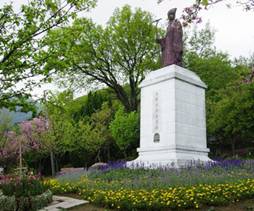 In the Front Mountain Park, there are many pavilions and crystal streams running down from the lower mountain valleys through bridges passing along both banks of the delicate and exquisite Yangmin Lake, planted with azalea and cherry flowers. Going boating on the lake, it looks as if one placed himself in the picturesque landscape of South China. On the side of the path leading to Jin Mountain of the Front Mountain Park, there is a "Grass Mountain Waterfall" as crystal clear as a white ribbon, flowing endlessly all the year round.
There lies a well-known hot spring in the Yangminshan Scenic Spot, which is one of the four biggest hot springs of Taiwan, springing out of the Qixing Mountain foot, proved to be pure hydrogen sulphide spring. The flow of the spring is enormous and breaks into streams running endlessly all the year round.
Furthermore, Yangminshan Scenic Spot is also famous for its grasslands, the maple red leaves, butterflies, multi-colour birds and such wildlife animals as hares rhesus monkeys and others.
Sun Moon Lake
Sun Moon Lake is located in Nantou County, Taipei City. It is surrounded by Mount Shuishe and Mount Dajian. The lake covers an area of 7.7 square kilometers and has an average water depth of 40 meters. The lake is divided into northern and southern sections by an island called Guanghua. The lake gets its name because the northern section resembles a rhombus-shaped sun while the southern section looks like a crescent-shaped moon.
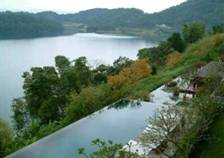 According to legend, a white deer contributed to the discovery of the lake. Three hundred years ago, a group of peasants were hunting when they discovered a large white deer running to the northwest. They followed this amazing creature for three days and nights, but it finally disappeared in the forest. On the fourth day, after they had moved through the forest, they came upon an impressive vista. They saw rolling verdant mountains and a shimmering lake shining brightly under the sun. A small round island covered with trees divided the lake into two parts. One part was like the sun and the other part was like the moon, so they called it Sun Moon Lake. Attracted by the fertile soil and beautiful scenery there, the peasants decided to settle down and began a new life.
Taipei 101
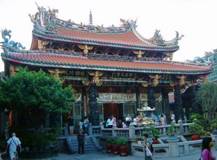 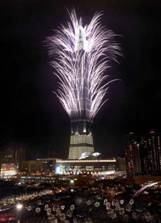 The Guinness Book of Records certified Taipei's grandiose financial centre, known as Taipei 101, as the world's tallest building in October 2003. It will soon be overtaken by a new building under construction in Dubai, however (due for completion in 2009), but at more than 1671 feet (509m) high, designed to resemble a towering pagoda, this building will likely remain not only the city's major landmark, but also an awesome tourist attraction, for generations to come. A trip up and down in one of the super-fast lifts takes only minutes, and the view from the top observation deck is of course spectacular. The lower levels are crammed with shops and restaurants. Address: 3/F 45 Shi Fu Road; Telephone: (2) 8101 8899; Website: www.tfc101.com.tw; Transport: Taipei 101 is the core of the Hsin-Yi Master Planned Area and is connected to neighbouring buildings by pedestrian skyways. Shuttle buses run to and from the City Hall MRT station, and it is served by multiple bus routes from all areas of the city; Opening time: Daily 10am to 10pm (last entry at 9.15pm); Admission: NT$350 (adults), NT$320 (children under 110cm tall). Group concessions available
Longshan Temple
Of the many temples in Taipei, the Longshan Temple, dedicated to Guanyin, the Goddess of Mercy, is one of the most popular and represents an excellent example of the architecture commonly seen in older buildings in Taiwan. It was built in 1738 to serve as a place of worship for Chinese settlers, and has had a troubled history, being destroyed several times by earthquakes, fires and even American bombers during World War II. Undaunted, Taipei residents have rebuilt it each time, and it is now still very much in use.
Address: 211 Guanghzhou Street; Opening time: Daily 6am to 10.20pm
Chiang Kai-shek Memorial Park
 Pride of Taipei, the magnificent Chiang Kai-shek Memorial Park is a walled complex built in memory of the former Taiwanese President. It contains an impressive pyramid-shaped majestic white monument to Chiang Kai-shek, capped with a blue-tiled roof, as well as the National Concert Hall and National Theatre. All stand inside a lovely park, fronted by a vast plaza where there are often folk performances or other events being held. The Memorial is also the main venue for Taipei's famed Lantern Festival, Shang Yuan, which draws thousands of lantern-carrying revellers to mark the Chinese New Year. Address: South Road, Chungshan; Transport: MRT lines Danshui-Xindian, or Beitou-Nanshi, alighting at the CKS Memorial Hall Station
Taipei Zoo
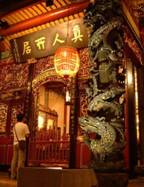 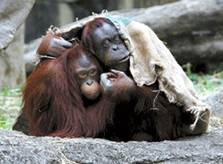 Meet the local Taiwanese animals, like the flying fox, Asiatic Black Bear and the Chinese Pangolin in the Taipei Zoo. All these species, and hundreds of others, are happily housed in the zoo, which provides a fun day out for everyone. Arranged in habitats like an Asian Tropical R ainforest section, desert area and even African savannah, the zoo, founded in 1914, covers 165 hectares and includes an extensive indoor area. Address: Hsinguang Road, Muzha; Website: english.taipei.gov.tw/zoo; Transport: MRT Muzha Line, Taipei Zoo station. Cable cars connect the zoo with Maokong and Zhinan Temple; Opening time: Daily 9am to 5pm (closed on Chinese New Year); Admission: NT$60 (adults). Concessions available
Baoan Temple
Baoan Temple was built in 1805, and complete in 1830. The temple's main deity is Baosheng Dadi, the god of medicine. By the way, the art of the building is Taiwan's best, and the temple is the winner in the 2003 UNESCO Asia-Pacific Heritage Awards. The temple is located at 16 Hami Street, The nearest MRT station is 'Yuanshan' on the Danshui Line. Baoan Temple
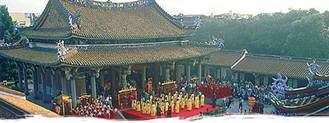 Confucius Temple- Confucius Temple- Just next to the Baoan Temple, The Confucius Temple was built in 1879 when the Qing Court changed Taipei into a prefecture of the Province of Fujian, China. It was established to serve as the largest educational center in northern Taiwan. Every September 28th, a large number of people from Taiwan and abroad come here to watch a solemn Confucius birthday ceremony and eight-row dance. The temple is located at 275 Dalong Street. The nearest MRT station is 'Yuanshan' on the Danshui Line. Confucius Temple
Xingtian Temple - Located at the corner of Minquan East Road and Songjiang Road. The temple built in 1967 devoted to Guanyu, a famous deified general who lived during the Three Kingdoms period, and he is an important character in the Chinese classic Romance of the Three Kingdoms. The temple forbids the killing of offering of animals, so you will see offerings of only fresh flowers, fruits and tea on the main altar. Many believers feel that this is a very efficacious temple, and it is frequently thronged with people praying for help and seeking divine guidance by consulting oracle blocks. Outside the temple, the underground pedestrian passages under the Minquan - Songjiang intersection are filled with fortune-tellers and vendors who take commercial advantage of the temple's popularity. Xingtian Temple
City Gates
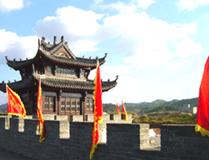 Even though very little ancient architecture remains in Taipei, four of Taipei's five original city gates still stand. The city walls which surrounded the old city, as well as the West Gate, which used to stand at the current location of Ximending, were demolished by the Japanese to make way for roads and railway lines. Of the four gates still standing, the Kuomintang "renovated" three of them in its effort to "sinicize" Taipei and converted them from the original southern Chinese architecture to northern Chinese palace style architecture, leaving only the North Gate in its original Qing Dynasty splendour today. This gate just sits forlornly in the traffic circle where Zhonghua, Yanping and Boai roads meet.
Parks
Daan Forest Park, one of Taipei's newest parks.The park rests on twenty- Daan Forest Parksix hectares in central Taipei bordered by Xinyi Road, Jianguo South Road, Heping East Road, and Xinsheng South Road. Due to its size and location, it is also known as Taipei Central Park. Buses: 15, 52, 235, 278, 284, 20, 22, Xinyi Main Line.
Taipei Botanical Garden, Nearest MRT station 'Xiaonanmen' on the green line between the MRT Ximen station and MRT C.K.S Memorial Hall station. This beautiful garden have inspired the citizens of Taipei for over one hundred years. The lotus ponds are a hallmark of the park and are especially captivating when the these symbols of peace are in full bloom and swaying in the summer breeze. Close to the National Museum of History. (see Museums/Galleries section)
228 Peace Park, on the north side of Katagalan Blvd, and the MRT station 'National Taiwan University Hospital' on the Danshui line. The park was founded by the Japanese in 1907, and originally called New Park. The name was changed in 1996 to commemorate those killed in the 228 Incident of 28 February 1947. The park is popular with practitioners of taichi and senior citizens playing Chinese chess. The National Taiwan Museum marks the northern entrance to the park. (see Museums/Galleries section)
Zhongshan Fine Arts Park, South of the Taipei Fine Arts Museum.The open green space and many stabiles are display in the park.
Dajia Riverside Park, the park is a 12-km-long green belt on the south bank of the Keelung River.One of the beautiful banks in Taipei.The exercise facilities, like basketball, tennis, badminton are available, meantime, the bike rent is also accommodated there.The Red 34 bus between the MRT Yuanshan station (Danshui Line) and Dajia Riverside Park.
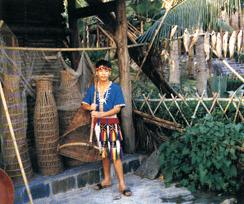 Zhishan Hill Park Zhishan Hill Park, a small hill is located in the south of Tianmu, close by the Yang-ming Hospital. The Zhishan Hill (Zhishanyan), one of the oldest archaeological excavation sites in Taiwan. Along the trail, you can see many historic heritages in this hill, the Huiji Temple, Fortified Gate, small temple and an old camphor tree over 300 years old. Out of the MRT Zhishan Station (Danshui Line) and walk for about 15 minutes.
Aborigine Culture Park, is situated beside the National Palace Museum, opposite the Sung Ye Museum of Formosan Aborigines. The theme of the park is the aboriginal culture. There are thirteen stone-slab sculptures stand in the entrance of the park, depicting the people of Taiwan's nine tribes in their traditional costumes.

Editor: canton fair |




